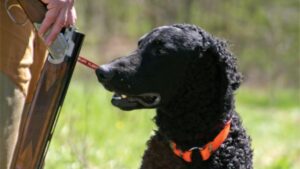
Judging the Curly-Coated Retriever
Explore the distinct traits and judging standards of the Curly-Coated Retriever, focusing on their athletic build and unique field abilities.
Home » Meet The Breeds » Curly-Coated Retriever
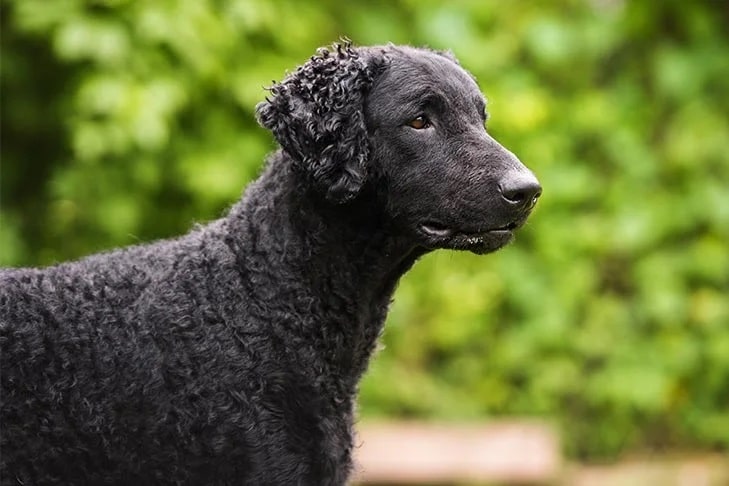
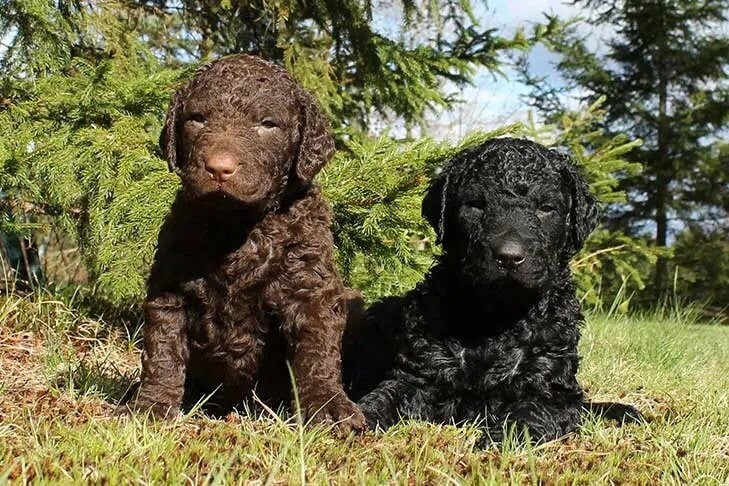

The Curly-Coated Retriever, often referred to simply as the “Curly,” stands out among the retrievers in part because of its distinctive curly coat. As one of the oldest retrieving breeds, the Curly has been cherished for its versatility in hunting and for its confident and independent nature. Balancing playfulness with poise, this stylish breed is known for its loyalty, intelligence, and enduring energy.
Sporting
23 – 27 inches
60 – 95 pounds
10 – 12 years
| Country of Origin | England |
|---|---|
| Bred For | Retrieving Birds, Companionship |
| Known For | Curly Coat, Intelligence, Loyalty |
| Popularity | Low |
| Temperament | Confident, Proud, Intelligent, Alert |
| Activities | Hunting, Running, Therapy Dog, Conformation Shows, Dog Sports, Rescue Dog |
The Curly-Coated Retriever is among the oldest of the retrieving breeds, boasting a lineage that stretches back to the early 19th century in England. The breed’s precise ancestry remains a subject of debate among canine historians, but it’s widely believed that they resulted from a mix of the now-extinct English Water Spaniel, the St. John’s Newfoundland, the retrieving setter, and possibly the Poodle. The breed’s unique curly coat was bred intentionally to serve as an efficient water-resistant barrier, making these dogs particularly adept at waterfowl retrieving in marshy conditions.
As skilled hunters, they became increasingly popular among English gamekeepers and hunters for their proficient retrieving abilities, both in water and on land. The breed was known to be able to handle the rugged terrains and adverse weather conditions of the English countryside, proving to be resilient, tenacious, and hardworking.
The Curly-Coated Retriever’s reputation crossed borders, and by the late 19th century, the breed had made its way to Australia and New Zealand, where the dogs were equally appreciated for their working skills and companionship.
The American Kennel Club (AKC) recognized the Curly-Coated Retriever in 1924, and the breed’s popularity in the United States grew slowly but steadily. Although never achieving the same widespread acclaim as some of the other retriever breeds, the Curly-Coated Retriever has maintained a loyal following of enthusiasts dedicated to preserving its unique characteristics and abilities.
Today, while still treasured as hunting companions, the Curly-Coated Retriever is also celebrated in various Dog Sports, Conformation Show rings, and most importantly, as beloved family pets. The history of the Curly is a testament to the adaptability, resilience, and enduring charm of this unique breed.
Adult males typically stand between 25 and 27 inches tall at the shoulder, while mature females range from 23 to 25 inches.
Curly-Coated Retrievers typically weigh between 60 and 95 pounds, with females generally weighing less than the males.
The Curly-Coated Retriever possesses a balanced build, ensuring strength without sacrificing agility. The length of the body is slightly longer than its height, giving it an off-square silhouette. The Curly showcases sturdy bone that’s complemented by well-muscled hindquarters and a deep chest, emphasizing its capacity for endurance and power.
Texture: The Curly-Coated Retriever’s coat is quite distinctive and is unlike that of any other breed of dog. The neck, body, and rear legs are covered in a thick mass of small, tight curls. However, the muzzle, forehead, fronts of the forelegs, and the feet are covered in short, smooth, and straight hair. Bald patches anywhere on the body are unacceptable as is a coat that is sparse, very harsh, brittle, fuzzy, or silky. The Curly’s coat should remain dense throughout, ensuring the dog is well-equipped for working both in and out of the water.
| Standard Color | |
|---|---|
| Black | ee |
| Liver | ee |
Markings: This purebred dog has no markings.
A Note About Color: The Curly-Coated Retriever is a solid, self-colored dog in either black or liver. White hairs are allowable on an otherwise good dog, but a prominent white patch of hair is unacceptable in the breed.
The tail of the Curly-Coated Retriever is an extension of its agile and balanced build and plays a vital role in both movement and expression. Set just below the level of the back, it is carried straight or with a slight upward curve. It should never, however, curl over the back. The tail is of medium length, reaching approximately to the hock, and showcases the breed’s characteristic curls. In action, the tail functions as a rudder, assisting with balance in or out of the water. When the Curly is alert or active, the tail’s movement reflects its energy and mood.
The tail is never docked for this breed, its natural length adding to the Curly-Coated Retriever’s distinctive and elegant appearance.
Owning a Curly-Coated Retriever brings joy, energy, and a touch of mischief to a household. As one of the oldest retrieving breeds, Curlies are known for their distinctive coat and effervescent personalities. They are highly versatile dogs, excelling in various canine sports and activities, Most make loving family companions, but their intelligence and independence can be both a delight and a challenge. Consequently, Curlies are a suitable choice for experienced dog owners.
Curly-Coated Retrievers, like all breeds and mixed breeds, can have specific health concerns that potential owners should be aware of. While they are generally robust and healthy dogs, it’s crucial to provide regular veterinary check-ups and maintain a proactive approach to their well-being. With proper care, these retrievers tend to lead fulfilling lives that brim with vitality and fun.
Lifespan: The average lifespan for a Curly-Coated Retriever ranges between 10 and 12 years.
Curly-Coated Retrievers, despite their robust nature, can be predisposed to certain health conditions. Being informed about these potential issues is vital for early detection and treatment. Some of the common concerns for this breed include:
Being proactive about a Curly-Coated Retriever’s health starts with regular veterinary care. Check-ups can help to detect and address health issues early on, ensuring the dog’s well-being and increasing its longevity. Regular health screenings, a balanced diet, and proper exercise can further support overall good health and a life that’s fulfilling and fun.
Curly-Coated Retrievers are often described as confident, independent, and exuberant, bringing an unmatched vibrancy to any household. Their keen intelligence, paired with their playful nature, makes them engaging companions, though sometimes their independent streak might come across as stubbornness. This trait, while endearing to many, can pose challenges for novice dog owners. It’s essential to establish leadership and consistency in training from a young age.
Socialization is a critical aspect of the Curly-Coated Retriever’s upbringing. Properly socialized Curlies are known to get along well with other dogs and can be quite gentle with young children. They tend to be more reserved around strangers, but rarely aggressive, often warming up once they assess the situation. Their inherent retrieving instincts make them naturally playful and interactive, always eager to fetch or play.
Despite their occasional bouts of independence, Curly-Coated Retrievers thrive on human companionship. They are loyal to their families and do not enjoy being left alone for extended periods. Providing them with interactive toys or puzzle feeders can help to keep them engaged during short periods of solitude. In a family setting, they often form deep bonds with everyone, ensuring their place as cherished family members.
Feeding a Curly-Coated Retriever requires understanding nutritional needs at various life stages. As active dogs, Curlies require a balanced diet that fuels their energy and sustains their muscular build. Always ensure that the food provided meets the specific needs of this breed, taking into account factors such as age, activity level, and overall health.
Puppies are ever-growing and need a diet rich in protein and essential nutrients to support their development. It’s often recommended to feed Curly-Coated Retriever puppies three to four times a day, gradually transitioning to twice-a-day feeding as they approach adulthood. High-quality puppy food designed for large breeds can be beneficial during this stage.
For adult Curly-Coated Retrievers, a diet that includes lean proteins, healthy fats, and essential vitamins and minerals is ideal. On average, an active adult might consume 2.5 to 3.5 cups of high-quality dry dog food daily, divided into two meals. However, it’s crucial to adjust the quantity based on the dog’s activity level and metabolism. Overfeeding or providing calorie-dense treats without enough exercise can lead to obesity, a condition you’ll want to avoid for the overall health and longevity of your Curly.
Always ensure the Curly-Coated Retriever has access to fresh and clean water. Keeping an eye on the dog’s weight, monitoring for any sudden changes, and having regular vet consultations can help to ensure that their nutritional needs are being met adequately. Remember, every dog is an individual, so adjustments might be necessary based on a dog’s specific requirements and any health concerns.
The Curly-Coated Retriever’s intelligence and eagerness to please can make training a rewarding experience, but the breed’s independent nature can sometimes present challenges. Their self-assured demeanor means that they may occasionally decide to do things their own way. Thus, early training and consistent leadership are paramount to mold them into well-behaved companions.
Curlies respond best to positive reinforcement techniques. Harsh training methods or undue punishment can lead to a distrustful or even more stubborn dog. Incorporating games, especially retrieving games, into their training regimen can capitalize on their innate abilities and make sessions more engaging for them. It’s also essential to keep training sessions relatively short and varied enough to hold their interest.
Socialization is another vital aspect of training. Exposing your Curly to various environments, people, and other animals from a young age will help them develop into well-rounded, confident adults. This breed’s inherent caution around strangers makes early and consistent socialization even more crucial to prevent excessive shyness or undue apprehension.
Despite their somewhat independent streak, Curly-Coated Retrievers have the potential to excel in Obedience and Agility Trials. Their keen senses and natural retrieving instincts can also make them standouts in Field Trials. Engaging them in such activities can not only enhance their skills but also strengthen the bond between dog and handler. With patience, understanding, and a bit of creativity, training a Curly can be a fulfilling endeavor for both the dog and the trainer.
Curly-Coated Retrievers are spirited and active dogs that require regular exercise to keep them mentally stimulated and physically fit. Their origins as hunting and retrieving dogs mean they have a built-in drive for activity and will thrive in environments where they can channel this energy productively.
| Energy Level | High |
|---|---|
| Exercise Requirements | 1 Hour/Day, Daily Walks, Weekly Swimming, Regular Exercise, Playing with Another Dog, Mental Stimulation |
A daily routine should ideally incorporate not just walks but also more rigorous exercises like fetching, swimming, or running. A couple of brisk walks combined with some playtime can usually suffice for most Curlies, but remember, these are energetic dogs and they will appreciate more extended periods of activity.
Swimming is a particularly favored activity for many Curly-Coated Retrievers. Given their water-repellent coat and natural inclination towards water, they often take to swimming with enthusiasm. It’s also an excellent low-impact exercise, beneficial for their joints and overall well-being.
While they are playful and energetic outdoors, most Curly-Coated Retrievers can be quite calm indoors, making them adaptable to various living situations as long as their exercise needs are met. However, neglecting their physical requirements can lead to undesirable behaviors, such as chewing or digging, as they seek alternative outlets for their energy.
It’s also beneficial to engage a Curly’s mind. Incorporating training sessions, puzzle toys, and interactive games into the daily routine can help keep this dog mentally sharp. Activities that tap into the breed’s natural retrieving instincts, such as fetch or even scent tracking, can provide both physical and mental stimulation, ensuring a happy and well-adjusted Curly.
Grooming a Curly-Coated Retriever is relatively straightforward, owing to the breed’s unique curly coat. This Curly is known for its water-resistant, tight curls that cover the body, providing protection in rough conditions or when swimming. This natural protective layer means that Curlies don’t require frequent baths unless they get particularly dirty.
| Coat Type | Thick, Tight, and Crisp Curls, Water Resistant, Weather Resistant |
|---|---|
| Grooming Requirements | Infrequent Brushing, Occasional Bathing, Routine Ear Cleaning, Periodic Nail Trimming, Regular Tooth Brushing |
While they do shed, the Curly-Coated Retriever’s shedding is less noticeable than that of other breeds, given the nature of their curls. The tight curls can trap the loose hairs, making them less apparent around the house. However, a regular, gentle brushing once a week can help to remove these trapped hairs and keep the coat looking its best. When brushing, it’s essential to be careful to avoid breaking the curls.
Beyond brushing, it’s crucial to check the Curly’s ears regularly for signs of infection, given its love for water. Any moisture that remains in the ear can lead to bacterial growth. Cleaning them gently with a vet-approved solution can help to prevent any potential issues.
Their nails should be trimmed once or twice a month, or as needed, to prevent overgrowth and splitting. Regular checks of the Curly’s teeth and gums are also advised. Brushing the teeth a few times a week will help to maintain good oral health and fend off potential bad breath.
Living with a Curly-Coated Retriever is a rewarding experience, especially for those who appreciate an active and loyal companion. Known for their independent spirit and confidence, Curlies bring a distinct blend of energy and intelligence to the household.
In terms of housing, Curly-Coated Retrievers show remarkable adaptability. They certainly relish the expansiveness of a yard, but they are not averse to apartment living as long as they receive enough exercise. Their calm indoor demeanor, combined with their zest for outdoor activities, renders them compatible with diverse living arrangements. Nonetheless, having access to a secure yard where they can freely roam and play remains a distinct advantage.
Climate-wise, the Curly’s water-resistant coat offers protection against both wet and cold conditions. This makes the breed relatively tolerant of cooler weather, especially given its history of working in water and marshy terrains. However, like all dogs, the Curly should be protected from extreme weather conditions. During hot summer days, it’s essential to ensure that this dog has plenty of access to shade and water, and it’s important to avoid midday exercises when temperatures peak.
Socially, Curly-Coated Retrievers are often reserved with strangers but warm up once they get to know someone. Early socialization is crucial to ensure they grow up to be well-rounded and confident in different situations. Their natural alertness can make them good watchdogs, but they’re generally friendly and shouldn’t be considered an option as a guard dog.
Lastly, while Curlies cherish the time spent with their family, they are known for their independent nature. This means that while they might not always be the kind to constantly seek attention, they are always up for play, training, or a cuddling session whenever invited.
The puppy phase for the Curly-Coated Retriever is an enchanting time marked by boundless energy, a penchant for exploration, and of course, those characteristic curly coats beginning to take form. Puppies of this breed are vivacious, inquisitive, and filled with a youthful enthusiasm that’s hard to resist. From their earliest days, they display hints of the intelligence and independence for which the Curly-Coated Retriever is celebrated.
When bringing a Curly-Coated Retriever puppy home, preparation is key. Given the breed’s active nature, it’s essential to puppy-proof the living space, ensuring there are no hazards like loose wires or easily swallowed objects.
Early socialization is paramount. Exposing Curlies to a myriad of sights, sounds, experiences, and different people can help to shape them into well-adjusted adult dogs. Enrolling in puppy kindergarten can be beneficial, not just for basic obedience but also for the social interaction it provides.
A balanced diet tailored to the needs of large breed puppies is essential for the rapid growth phase. Consulting with a veterinarian about the best nutrition plan is always a wise decision.
Additionally, while Curlies may be little bundles of energy, it’s important to monitor and limit their physical activity. Over-exercising can put undue stress on their developing joints and bones. On the flip side, mental stimulation through games, toys, and simple training exercises can be introduced early.
Routine vet check-ups are crucial during this stage to ensure they are growing healthily and to initiate a vaccination schedule. Keeping up with regular deworming and flea and tick prevention is also indispensable.
Finally, it is important to instill good habits early. Training, grooming, and even basic commands are easier to teach when a Curly-Coated Retriever is young. This will lay the groundwork for a well-behaved and well-adjusted adult.
The Curly-Coated Retriever is an exuberant and agile breed, making it not only a superb hunting companion but also an excellent candidate for various dog sports and activities. The breed’s energy and intelligence mean it thrives when engaged in structured, fun activities that challenge both the body and mind.
Participation in these sports and activities not only keeps a Curly-Coated Retriever physically fit and mentally sharp, it also strengthens the bond between dog and handler. Moreover, it provides a fantastic avenue for socialization with other dogs and people.
The Curly-Coated Retriever is recognized by the world’s leading registries and kennel organizations, which categorize the breed into a specific Group based on its unique characteristics. This breed is recognized worldwide under the following Group designations:
| Organization | Group Designation |
|---|---|
| AKC (American Kennel Club) | Sporting |
| UKC (United Kennel Club) | Gun Dog |
| CKC (Canadian Kennel Club) | Sporting Dogs |
| ANKC (Australian National Kennel Council) | Gundogs |
| RKC (The Royal Kennel Club) | Gundog |
| FCI (Fédération Cynologique Internationale) | Group 8 – Retrievers – Flushing Dogs – Water Dogs ; Section 1 – Retrievers |
The ideal Curly-Coated Retriever is described by a Breed Standard that is approved by each of the world’s leading registries and kennel organizations. The Breed Standards for this breed may be found in the following links:
| Organization | Breed Standard |
|---|---|
| American Kennel Club | AKC Curly-Coated Retriever Breed Standard |
| United Kennel Club | UKC Curly-Coated Retriever Breed Standard |
| Canadian Kennel Club | CKC Curly-Coated Retriever Breed Standard |
| Australian National Kennel Council | ANKC Curly-Coated Retriever Breed Standard |
| The Royal Kennel Club | RKC Curly-Coated Retriever Breed Standard |
| Fédération Cynologique Internationale | FCI Curly-Coated Retriever Breed Standard |
Curly-Coated Retrievers have a small but dedicated following, with breed clubs around the world that support the preservation, education, and promotion of this distinctive breed. These clubs often play pivotal roles in championing responsible breeding practices, holding specialty shows, organizing events, and providing resources for both breeders and owners alike.
In the United States, the Curly-Coated Retriever Club of America (CCRCA), chartered in 1979, stands out as the parent club for the breed. Recognized by the American Kennel Club, it provides a plethora of information on the Breed Standard, breed health, social events, and more for Curly enthusiasts.
In the United Kingdom, the Curly Coated Retriever Club has been operational since 1910, making it one of the oldest breed-specific clubs in the UK. This club is deeply committed to the well-being of Curly-Coated Retrievers, offering resources on care, training, health, and various events.
For Curly-Coated Retriever enthusiasts, becoming a member of these established clubs can offer many benefits, from networking opportunities with fellow breed admirers to gaining access to exclusive events and insights.
The Curly-Coated Retriever, while loved by many, sometimes finds itself in need of rescue, rehoming, or rehabilitation. Dedicated rescue groups and organizations work tirelessly to ensure these dogs find loving forever homes, and they also play a crucial role in educating the public about the breed’s needs and characteristics.
In the US, the Curly-Coated Retriever Club of America Rescue Committee works tirelessly to help Curlies in need. The club assists with both adoptions and placements, ensuring each dog finds an appropriate and loving home.
Canada has individual breed enthusiasts and general retriever rescues that are ready to step in and offer assistance to any Curly-Coated Retriever in need. While there may not be a specific national Curly-Coated Retriever rescue group, these broader organizations can help individuals of this lesser-known breed.
In the United Kingdom, organizations like the RSPCA and Battersea Dogs & Cats Home could potentially receive a Curly-Coated Retriever in need of adoption, and there are other rescues and networks as well that can assist in rehoming and rescuing a Curly in need.
Curly-Coated Retrievers do shed, but typically less so than many other breeds. Their curly coats might appear low-shedding, but like most dogs, they have seasonal shedding periods, often once or twice a year.
No dog breed is truly hypoallergenic. However, Curly-Coated Retrievers might be more suitable for people with mild allergies due to the breed’s specific coat type. It’s crucial for potential owners with allergies to spend time around a Curly to gauge their reaction before deciding to adopt or purchase a dog.
The Curly-Coated Retriever is among the oldest retriever breeds and was developed in England. It was primarily bred from the now-extinct English Water Spaniel, the St. John’s Water Dog, and retrieving setters, with the aim of creating an efficient water retriever.
Yes, the Curly-Coated Retriever is an excellent family dog. The breed is known for its friendly disposition, high energy, and loyalty. A playful nature and patience often make the Curly a great companion for kids.
While Curly-Coated Retrievers are intelligent and trainable, they are not as commonly used as service dogs compared to breeds like Labrador or Golden Retrievers. However, with proper training, they can serve in roles like Therapy Dogs or Assistance Dogs.
While Curly-Coated Retrievers are independent when compared with some other breeds, they thrive on interaction and activity. Leaving them alone for extended periods can lead to boredom and potentially destructive behavior. If they need to be left home alone for brief periods, it is important to ensure they have interactive toys and are given sufficient space to exercise.
Curly-Coated Retrievers are not known to be excessive barkers. However, like most dogs, they might bark to alert their owners of unfamiliar visitors or unusual noises. Training and socialization can help to manage their barking tendencies.
Yes! The Curly-Coated Retriever was bred for hunting and retrieving, especially in water. The breed’s water-resistant coat, stamina, and enthusiasm make the Curly an effective hunting companion, particularly for waterfowl.

Explore the distinct traits and judging standards of the Curly-Coated Retriever, focusing on their athletic build and unique field abilities.

Explore a journey through nostalgia as spring cleaning unveils forgotten treasures from a lifetime in the world of dogs. Memories await!
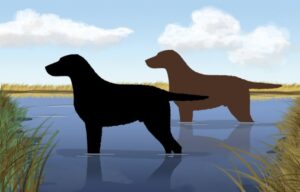
The Curly-Coated Retriever has a unique profile that distinguishes it from other breeds. The characteristic silhouette of an erect, upstanding, athletic-appearing Curly-Coated Retriever is achieved through the body shape, proportion, and substance, coupled with the head and tail, that create a distinctive outline.

Kathy & Scott Shifflett of Kurly Kreek share their journey breeding top Curly-Coated Retrievers with purpose, passion, and precision.

Scott & Kathy Shifflett are the breeders behind Kurly Kreek Curly-Coated Retrievers. Read about the kennel’s beginnings, puppies.

Victor Hewer is the breeder behind Tyneside Curly-Coated Retrievers. Read about the kennel’s beginnings, puppies, and much more!
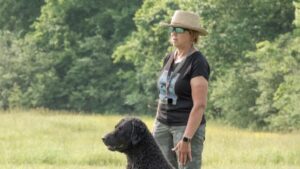
Iris Andre is the breeder behind Pizzazz Curly-Coated Retrievers. Read about the kennel’s beginnings, puppies, and much more!

Kathy and Scott Shifflett are the breeders behind Kurly Kreek Curly-Coated Retrievers. Read about the kennel’s beginnings, the dogs, and more!
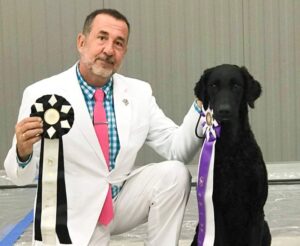
Victor Hewer is the breeder behind Tyneside Curly-Coated Retrievers. Read about the kennel’s beginnings, the sires, the dams, and more!
The best way to ensure a long and happy relationship with a purebred dog is to purchase one from a responsible breeder. Not sure where to begin?
Contact the National Parent Club’s Breeder Referral Program, which is listed on the AKC Breeder Referral Contacts page.
